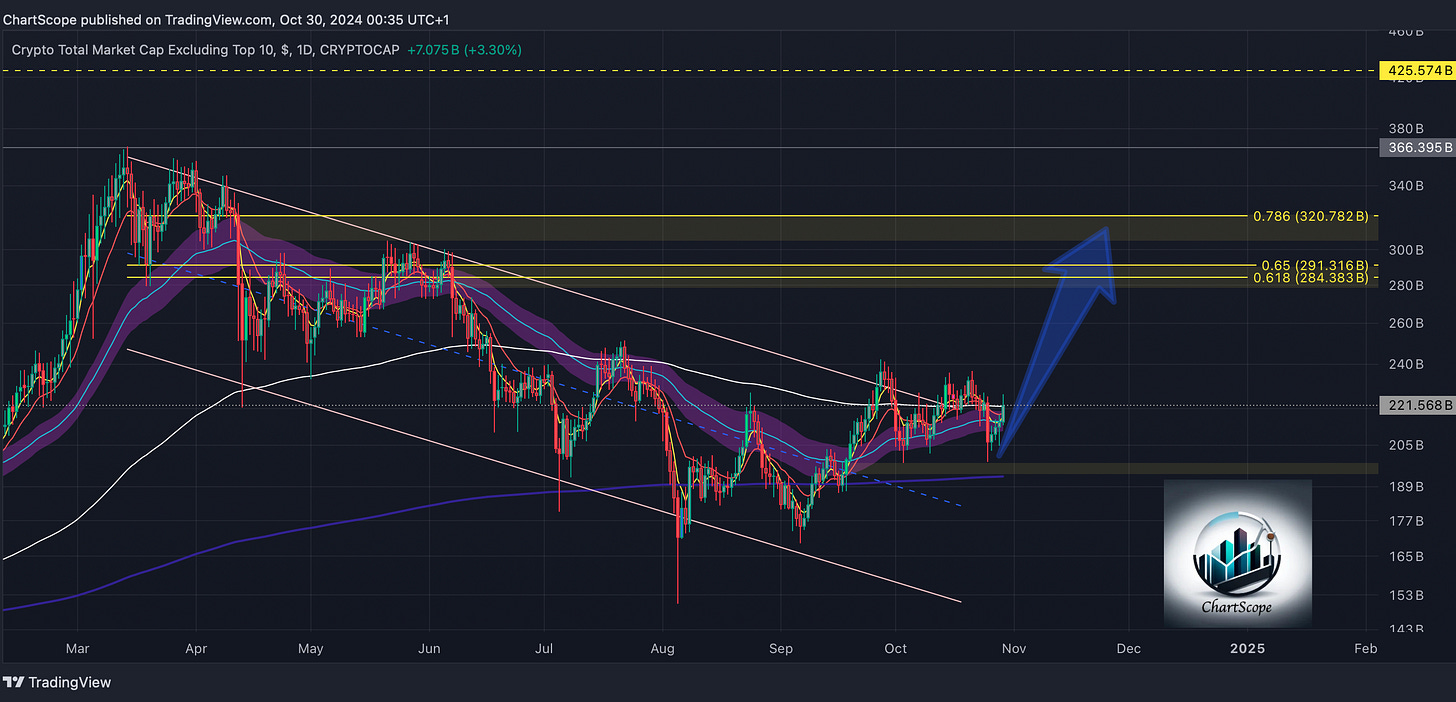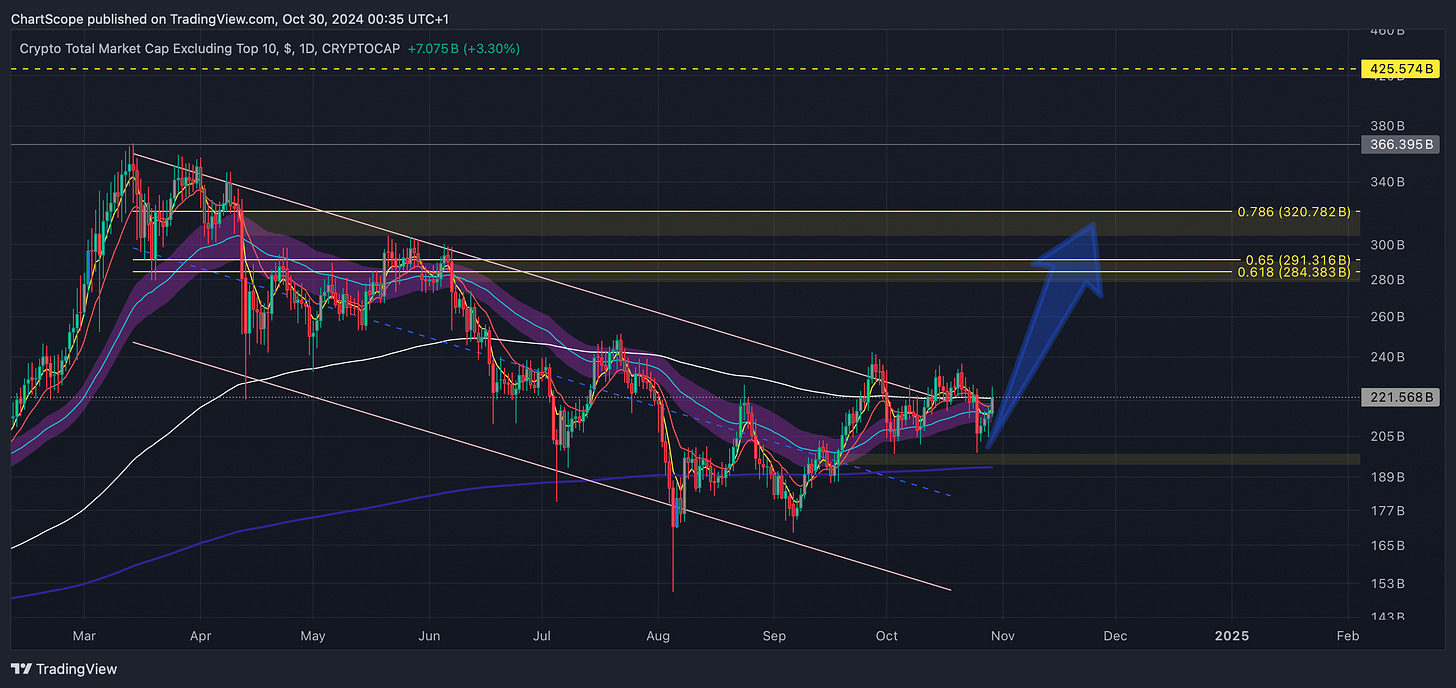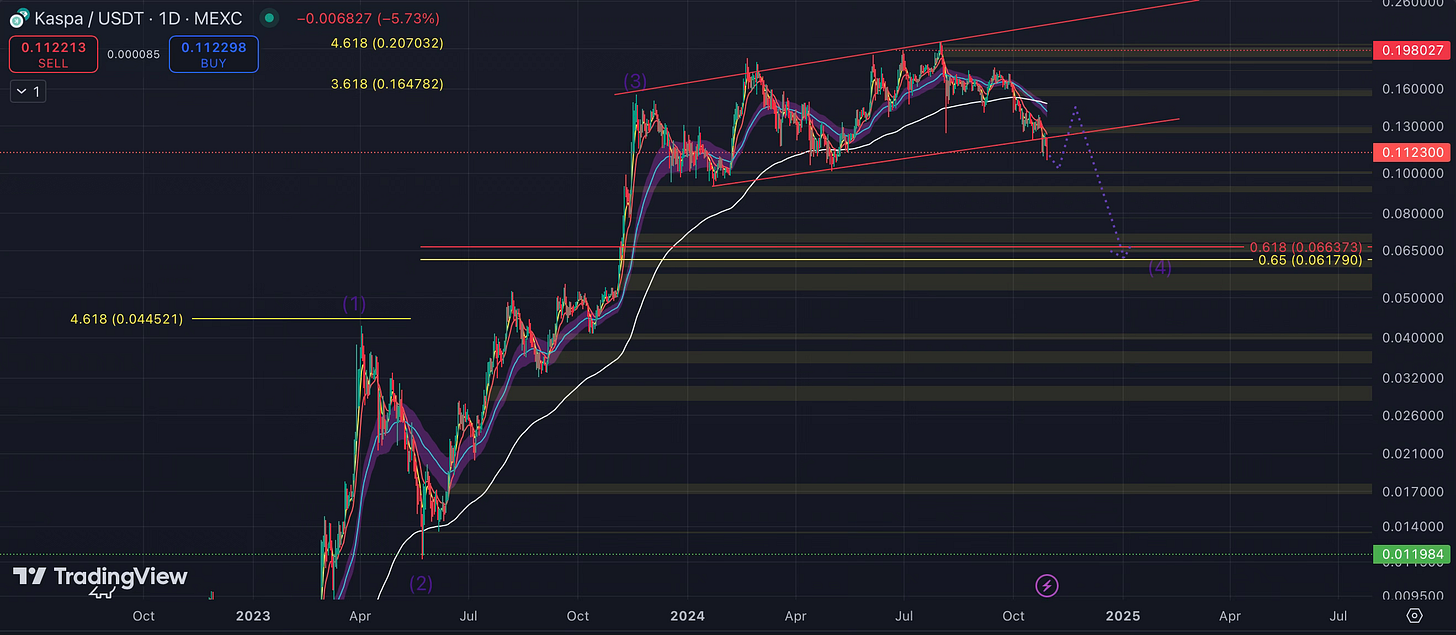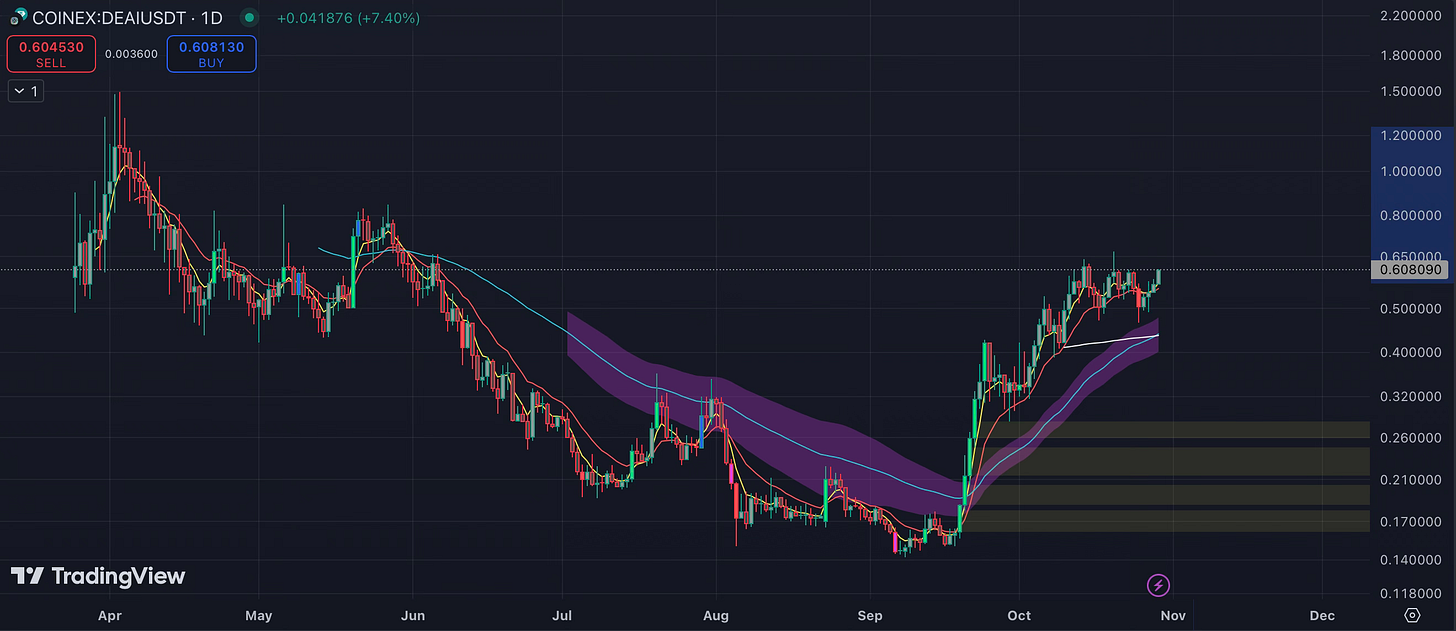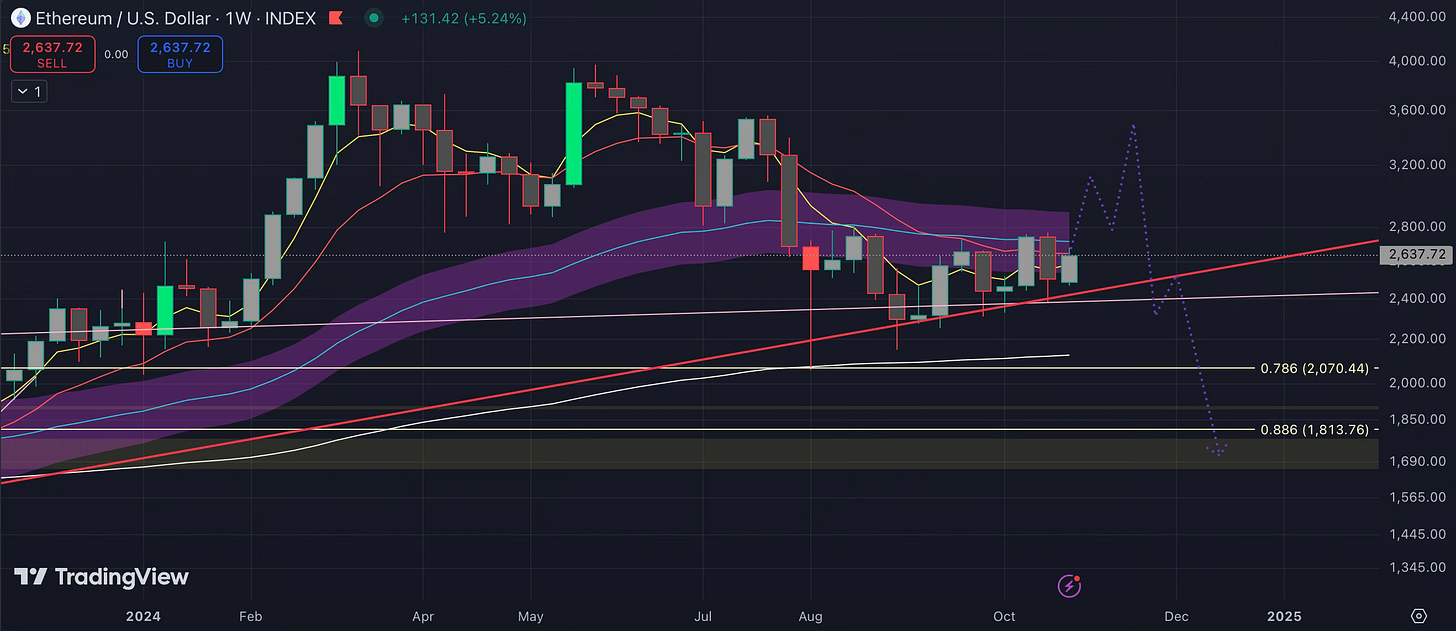Altcoin Market Dynamics: Resilient Growth in Crypto’s Emerging Stars
Assessing Altcoin Trends, Portfolio Update, and Potential Paths as Markets Shift
Introduction: Altcoin Market at a Turning Point 🫀
In the fast-moving world of cryptocurrency, one key factor continually shapes market sentiment: Bitcoin $BTC.
Bitcoin Dominance: Insights for the Next Crypto Bull Run
ChartScope: Actionable Market Insights & Data Analysis is a reader-supported publication. To receive new posts and support my work, consider becoming a free or paid subscriber.
From highs to lows, Bitcoin often sets the stage, creating ripple effects felt across the broader crypto space, especially among altcoins. While Bitcoin grabs the spotlight, thousands of altcoins—cryptocurrencies other than Bitcoin—play vital, often under-the-radar roles in advancing blockchain technology and driving new use cases.
Altcoins, ranging from established projects like Ethereum to emerging assets with niche applications, are where innovation in crypto thrives. Today, we’re examining these assets in-depth, looking at recent price movements, resistance levels, and trends in a specific segment we refer to as the “$OTHERS” chart. This chart captures the market dynamics of altcoins that aren’t in the top 10 by market cap, allowing us to focus on the hidden gems and rising stars that may drive the next wave of growth.
Altcoin Market Overview 👀: Tracking Growth in the “Others” Segment
The “Others” chart provides a snapshot of the altcoin market’s health by tracking assets outside the top 10, excluding Bitcoin. This particular segment of altcoins has been making a comeback, showing bullish signs after a period of consolidation. In recent weeks, we've witnessed a steady rise in market capitalization, signaling renewed interest and capital flowing back into altcoins.
Altcoins, which often follow Bitcoin’s lead, have been exhibiting increased resilience. We’re seeing them hold key levels despite broader market volatility. In the “Others” chart, we’ve identified several critical resistance zones that will play pivotal roles in the days ahead. These zones, highlighted in yellow, range from around $280 billion to $320 billion. For altcoins to continue their climb, these levels will need to be broken, a move that would signal to investors that the bullish trend is here to stay.
The chart also shows Fibonacci retracement levels, with a prominent one at the 0.618 level—a key technical area that can often signal a reversal. This level could act as a pivotal point if the altcoin market retraces, offering support to stabilize prices before the next rally. Alongside this, several diagonal trendlines signal that altcoins are potentially breaking out from a previously downward trend. If they continue to rise along these channels, it would reinforce a shift in market sentiment towards altcoins, showing that investors are again willing to take positions in assets outside of Bitcoin.
Overall, the “$Others” segment has a promising outlook. As highlighted by a blue arrow in our chart, there’s a clear path for a potential climb, pointing towards the next resistance area. Should this momentum persist, we could see an altcoin rally that may even reach previous highs, affirming the market’s renewed confidence in crypto’s alternative assets.
Altcoin Spotlight: Exploring Moonwell, Kaspa, and DEAI
In the vast landscape of altcoins, three notable assets are standing out due to their distinct projects, growth potential, and the unique roles they play within the broader crypto ecosystem. Moonwell, Kaspa, and DEAI each offer something different, yet each represents an area of blockchain development that has sparked widespread interest. From innovative consensus protocols to AI-driven blockchain capabilities, these tokens show the diversity and ambition that drive the altcoin market forward. Let’s dive deeper into each one to understand their value propositions, current performance, and potential future paths.
Moonwell (WELL) 🤠: Pioneering Decentralized Finance on Base
Moonwell is a decentralized finance (DeFi) protocol built on Base and Moonbeam networks, designed to offer lending and borrowing services directly on-chain. Through its user-friendly design and a strong focus on security, Moonwell aims to bring DeFi to a wider audience, leveraging the robustness and speed of the Polkadot ecosystem.
Moonwell’s unique position in the market comes from its focus on cross-chain compatibility. As a protocol within the Polkadot and Base ecosystem, it can interact with a variety of blockchains. This interoperability opens up possibilities for Moonwell to expand beyond typical DeFi offerings by connecting with other blockchains and even different DeFi ecosystems. Moreover, Moonwell employs automated risk management protocols and uses oracles for price feeds, making it both user-friendly and secure. This emphasis on security and accessibility has helped Moonwell capture the interest of investors and users alike, particularly as the DeFi space continues to expand.
On the technical analysis front, Moonwell’s chart indicates that it may be entering a significant uptrend. It’s currently displaying a classic Elliott wave structure, with a potential for a “wave 5” upward movement—a pattern commonly associated with sustained bullish trends. Key support has formed at around $0.063, creating a solid base from which Moonwell might continue its ascent. Fibonacci extensions applied to its recent price action suggest potential targets in the $0.28 to $0.36 range, which could offer substantial upside if the bullish trend continues. Given this technical backdrop, Moonwell’s DeFi-driven fundamentals, and its strategic positioning in the Polkadot ecosystem, it’s clear why this asset is capturing market attention.
Kaspa (KAS) 🦾: Redefining Blockchain Through High-Speed Block Production
Kaspa is a Layer 1 blockchain that sets itself apart with a unique technology known as blockDAG (Directed Acyclic Graph). Traditional blockchains, including Bitcoin and Ethereum, follow a linear structure where one block follows the next. Kaspa, however, employs a blockDAG, allowing multiple blocks to be generated and confirmed simultaneously, which significantly increases throughput and lowers confirmation times. In practical terms, this means Kaspa can handle a much higher number of transactions per second compared to traditional blockchain designs, positioning it as a highly scalable solution for a variety of use cases.
In the world of Layer 1 blockchains, scalability is a recurring challenge. Many networks struggle to balance speed, decentralization, and security—a problem known as the blockchain trilemma. Kaspa’s approach is groundbreaking because it essentially bypasses this trilemma by creating a network where transaction speed and decentralization do not come at the expense of security. With the potential to produce 10 blocks per second, Kaspa has one of the fastest block production rates in the industry, making it suitable for high-frequency applications such as decentralized exchanges, gaming, and financial transactions.
Kaspa’s recent performance on the charts shows a corrective wave pattern, suggesting it may currently be undergoing a short-term retracement. This could be a buying opportunity for long-term investors, especially if Kaspa finds support at key Fibonacci retracement levels around $0.066 and $0.08. The price is also approaching a critical area on its exponential moving average (EMA), which has historically provided a strong support base during downturns. While it’s experiencing a consolidation phase, Kaspa’s fundamentals remain robust, and its unique technology positions it as a potential leader in blockchain scalability.
DEAI 🌟: The Emerging AI-Driven Blockchain Solution
DEAI, an emerging player in the blockchain space, is setting its sights on artificial intelligence, positioning itself as a successor to TAO. DEAI’s mission is to integrate AI capabilities directly into blockchain infrastructure, allowing the network to support advanced AI-based applications. This concept places DEAI at the intersection of two rapidly growing sectors—blockchain and AI—creating a unique space where it can cater to projects that require both the security of blockchain and the analytical power of AI.
As an “AI chain,” DEAI leverages machine learning algorithms within its network to enhance transaction processing, automate various aspects of governance and enable advanced data analytics directly on-chain. This means that applications built on DEAI could potentially access AI-driven insights, automate decision-making processes, and even adapt over time based on the data they interact with. Given the increasing demand for AI and blockchain applications, DEAI is well-positioned to capture attention from projects seeking to leverage both technologies.
Since reaching a low, DEAI has shown promising upward momentum, and many analysts predict it could soon revisit its all-time high (ATH) in the $1.4 to $1.5 range. However, achieving new highs will require sustained development, adoption, and community support. DEAI’s current market position is still young, which provides an attractive opportunity for early investors, though it’s crucial to recognize that this asset may require a longer holding period to reach its full potential. The AI-driven nature of DEAI makes it a forward-looking addition to any portfolio, especially for those interested in the intersection of artificial intelligence and decentralized technology.
A Diverse Altcoin Portfolio for a Dynamic Market
Moonwell, Kaspa, and DEAI illustrate the breadth of innovation happening in the altcoin space, each bringing a unique value proposition to the table. Moonwell capitalizes on the growth of DeFi, Kaspa redefines scalability through its advanced blockDAG structure, and DEAI explores uncharted territory by combining AI with blockchain. Each asset provides a different perspective on the future of crypto and blockchain, offering investors multiple paths for growth and diversification.
Ethereum (ETH) 👨💻: The Pioneering Blockchain’s Path and Future Prospects
Ethereum, the second-largest cryptocurrency by market cap, has long been hailed as the blockchain that brought programmability to the forefront of crypto. With its innovative approach to decentralized applications (dApps), smart contracts, and token standards like ERC-20, Ethereum opened the door to decentralized finance (DeFi), NFTs, and numerous other use cases that have since revolutionized the blockchain space. However, despite Ethereum's significant role and innovation, its recent price performance and market position have left many investors questioning its trajectory and long-term potential.
One of Ethereum’s defining moments came with the transition from Proof of Work (PoW) to Proof of Stake (PoS) through the Ethereum 2.0 upgrade, aimed at enhancing scalability, sustainability, and energy efficiency. While PoS has greatly reduced Ethereum’s energy consumption, the shift away from mining and reliance on validators has led to a loss of certain security assurances that PoW offered. Many argue that Ethereum’s move to PoS has shifted its identity, making it more comparable to a tech company with a focus on infrastructure than a strictly decentralized, math-driven protocol like Bitcoin. This perception shift has fueled comparisons that see Bitcoin as the “hard” money of crypto, with Ethereum viewed more as a versatile, technology-driven platform.
Ethereum’s price action has shown signs of stagnation over the past months, fluctuating within a limited range. While it has made attempts to break upward, it has faced consistent resistance, and overall market sentiment has shown that downward pressure could eventually bring it lower, possibly even to levels around or below $1,000. While Ethereum still holds significant technological advantages and maintains a large developer community, it faces increasing competition from Layer 2 solutions and other Layer 1 blockchain offering faster and cheaper transactions. Layer 2 scaling solutions like Optimism and Arbitrum are helping alleviate network congestion, but they also introduce complexities that some users may find challenging.
From a fundamental perspective, Ethereum remains the go-to platform for decentralized applications, and its established position makes it resilient. Its importance in the blockchain space is unparalleled, especially as most DeFi applications and NFT projects are Ethereum-based, maintaining high liquidity and active usage. However, some argue that Ethereum’s heavy reliance on Layer 2s and continuous shifts in its technical roadmap may dilute its value proposition, especially as it faces increasing pressure from faster, more efficient networks. Ultimately, Ethereum’s future trajectory will depend on its ability to innovate while retaining its core value as the foundational layer for decentralized applications. Investors should keep an eye on Ethereum’s roadmap and adoption metrics to gauge its potential as both a store of value and a utility-driven asset.
Our Portfolio Strategy 🔥: Balancing Innovation, Growth, and Stability in a Volatile Market

As the cryptocurrency market continues to evolve, our portfolio strategy is designed to capture growth in high-potential assets while managing risk through diversification. In crafting our approach, we’ve aimed to balance core, established assets with innovative, emerging projects. This allows us to participate in the growth of tried-and-tested projects while still having exposure to newer assets that could outperform in a bull market or introduce breakthrough technologies.
Keep reading with a 7-day free trial
Subscribe to ChartScope: Actionable Market Insights & Data Analysis to keep reading this post and get 7 days of free access to the full post archives.




